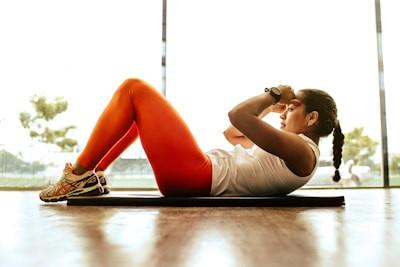A Guide to Exercise for Beginners
Curated from: verywellfit.com
Ideas, facts & insights covering these topics:
15 ideas
·54K reads
473
2
Explore the World's Best Ideas
Join today and uncover 100+ curated journeys from 50+ topics. Unlock access to our mobile app with extensive features.
Exercise: What We Know
We all know exercise is good for us. It offers documented health benefits and is probably one of the best tools we have to fight obesity, some types of cancer, diabetes, heart disease, and other chronic illnesses. At the same time, it can be hard to put that knowledge into practice. There are so many different suggestions on the types of activities and the ideal frequency, it can lead to information overload and overwhelm.
The most important thing to know is some exercise—any type of exercise—is better than no exercise.
905
5.29K reads
Benefits of Exercise
The wonderful thing about exercise is that you don't need much to get the benefits. Even just a few minutes a day can improve your health and well-being. Here are just some things exercise can help you do:
- Boost your mood
- Give you more energy
- Help you sleep better
- Increase bone density
- Improve your confidence
- Improve your quality of life
- Lose weight
- Reduce stress
930
4.31K reads
The FITT Principle
Use the FITT acronym to remember the exercise variables you can change to avoid plateaus and to keep your body challenged:
- Frequency: How often you exercise
- Intensity: How hard you exercise
- Time: How long you exercise
- Type: The type of exercise you're doing (e.g., running, walking, etc.)
1K
5.54K reads
Body Development: The Training Effect
When you work out at a sufficient intensity, time, and frequency, your body will improve (called the Training Effect) and you'll start to see changes in your weight, body fat percentage, cardio endurance, and strength. When your body adjusts to your current FITT levels, it's time to manipulate one or more of them.
924
4.91K reads
Optimizing Training Effect
If you've been walking three times a week for 20 minutes and you've stopped seeing improvement, you could change your program in one or more of the following ways:
- Frequency: Add one more day of walking.
- Intensity: Add short bursts of jogging, speed walking, or hill training.
- Time: Add 10 to 15 minutes to your usual workout time.
- Type: Do a different activity, such as cycling, swimming, or aerobics.
Changing any of these variables every four to six weeks can help you keep that training effect going.
1K
4.42K reads
The Overload Principle
In order to improve your strength, endurance, and fitness, you have to progressively increase the frequency, intensity, and time of your workouts. A simple way to stimulate your body is to try different activities.
- If you normally walk on the treadmill, try riding the bike which will use different muscles and allow you to burn more calories.
- If you've been doing biceps curls with dumbbells, change to a barbell.
911
3.97K reads
Specificity
This principle is just what it sounds like. It means your workouts should be specific to your goals. If you're trying to improve your racing times, you should focus on speed workouts.
If your main goal is simply health, fitness, and weight loss, you should focus on total body strength, cardio, and a healthy diet. Make sure your training matches your goals.
900
3.42K reads
Types Of Exercises: Cardio
Cardio exercise is any rhythmic activity performed continuously and can include activities like walking, running, aerobics, cycling, swimming, and dancing. Cardio strengthens the heart and lungs, increases endurance and burns calories, which helps you lose weight.
While you should always stick with a cardio program that fits with your fitness level, there are general guidelines for cardio programs based on your goals.
886
3.18K reads
Types Of Exercises: Strength Training
Strength training works the body in a different way than cardio and is equally as important for good health and weight loss. With strength training, you lift weights (dumbbells, barbells, resistance bands, machines, etc.) to strengthen the muscles, bones, and connective tissue.
Strength training builds lean muscle tissue, which raises metabolism helping you to reduce body fat9 provided you're also keeping your calorie intake in line. If you are new to resistance exercise and intimidated by using weights, bodyweight exercises, like squats, pushups, and planks, are a great way to start.
902
2.92K reads
Strength Training: Important Guidelines
- Choose eight to 12 exercises, targeting the major muscle groups (lower body, chest, back,shoulders, biceps, triceps, and abs).
- For beginners, do one set of eight to 16 reps of each exercise to fatigue. More advanced exercisers can do two to three sets.
- Train each muscle group two to three non-consecutive days a week.
- Work each exercise through its full range of motion and use good form.
968
3.29K reads
Types Of Exercises: Flexibility
While stretching is often the most overlooked exercise, it's important for keeping us agile as we get older. And, unlike the rigors of cardio and strength training, it's relaxing and it feels good.
- Stretching can be done anytime throughout the day, but it's also important to stretch after your workouts, especially if you have any chronically tight areas.
- Yoga workouts are a great way to both stretch your body at the same time you build endurance and promote relaxation and stress-reduction.
912
2.53K reads
Stretching Guidelines
- Do static stretches with a focus on tight areas, such as the hamstrings and lower back.
- Hold each stretch for about 15 to 30 seconds and do two to four reps of each stretch.
- Stretch a minimum of two to three days a week. Even better would be every day.
- Stretch within your range of motion. Stretching shouldn't hurt.
- Stretch your muscles when they're warm (after your warm-up or, even better, after your workout).
938
2.7K reads
The Importance Of Resting
While we often focus on getting in as much exercise as possible, rest and recovery are also essential for reaching your weight loss and fitness goals. While you can often do cardio every day (though you may want to rest after very intense workouts), you should have at least a day of rest between strength training workouts.
Make sure you don't work the same muscles two days in a row to give your body the time it needs to rest and recover.
896
2.45K reads
Finding Motivation
While it's important to know basic exercise guidelines and principles, the most important step in starting an exercise routine is exploring the idea of motivation. Without that, all the advice in the world won't do you any good.
Motivation doesn't just happen. It's something you make happen each and every day. If you have multiple reasons to exercise, you'll always have something to get you moving, even when motivation is hard to come by. The hardest part of exercise is getting started. If you can get that far, you've won half the battle.
897
2.18K reads
Motivating Tips
- Consider how much energy you'll have to get more things done.
- Imagine how relaxed you'll feel after a workout.
- Promise yourself a reward for completing your workout.
- Remind yourself how good you'll feel by following through.
- Remind yourself of your weight-loss goals.
- Remind yourself that this workout is necessary to reach your goal
- Think of a future event to get ready for (a wedding, a vacation, etc.).
- Think of all the diseases and illnesses your workout could protect you from.
993
2.88K reads
IDEAS CURATED BY
CURATOR'S NOTE
The ABC of Exercise and how to find motivation.
“
Ishank R's ideas are part of this journey:
Learn more about health with this collection
How to build positive relationships with colleagues and superiors
How to navigate office politics without compromising your values
How to handle conflicts and difficult situations in the workplace
Related collections
Similar ideas
11 ideas
1 idea
How Can I Burn More Fat When Exercising?
verywellfit.com
Read & Learn
20x Faster
without
deepstash
with
deepstash
with
deepstash
Personalized microlearning
—
100+ Learning Journeys
—
Access to 200,000+ ideas
—
Access to the mobile app
—
Unlimited idea saving
—
—
Unlimited history
—
—
Unlimited listening to ideas
—
—
Downloading & offline access
—
—
Supercharge your mind with one idea per day
Enter your email and spend 1 minute every day to learn something new.
I agree to receive email updates









